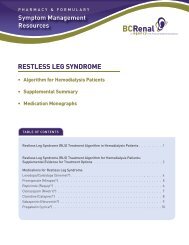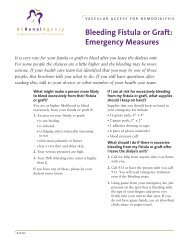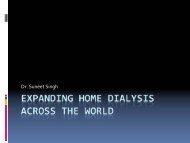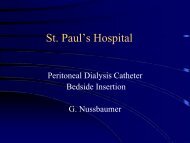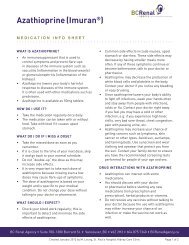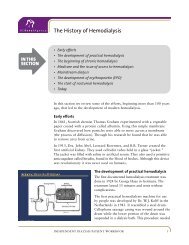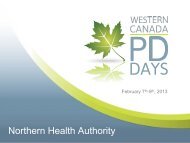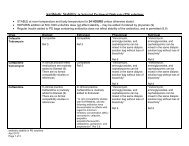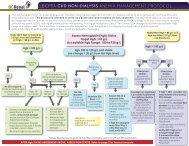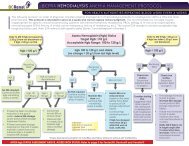Patient-Provider Relationships - BC Renal Agency
Patient-Provider Relationships - BC Renal Agency
Patient-Provider Relationships - BC Renal Agency
- No tags were found...
You also want an ePaper? Increase the reach of your titles
YUMPU automatically turns print PDFs into web optimized ePapers that Google loves.
<strong>Patient</strong>-<strong>Provider</strong> <strong>Relationships</strong>:Is the <strong>Patient</strong> a Better Driver?Dori Schatell, M.S.Executive Director, Medical Education InstituteDirector, Life Options Rehabilitation Program
YesNoIs the Typical <strong>Patient</strong>a Better Driver?
Medical Education InstituteMedical Education Institute• MEI has developed or worked on:
What We’ll CoverWhat We’ll Cover• Expert patients• Communication & health literacy• Autonomy• Educating for Self-management
“Begin with the end in mind”Steven Covey
Goal: Expert <strong>Patient</strong>sGoal: Expert <strong>Patient</strong>s“I enjoy making graphs out of my labtest data! I like to see how the valueshave changed over the years for thedifferent labs. I also keep track of andchart my weight gains and losses.”33 year hemodialysis patient
Goal: Expert <strong>Patient</strong>sGoal: Expert <strong>Patient</strong>s“My iron and Hgb are well within thestandards, but the Hgb is not highenough for me. A man’s Hgb (by thecharts) should be higher, because of therelative different body mass andactivity levels. The standards are notalways correct. I'm 5'10" and 172 lbs.I just don't feel well unless my Hgb isover 13! ”Hemodialysis patient
Goal: Expert <strong>Patient</strong>sGoal: Expert <strong>Patient</strong>s“Over the years (13 on hemo) I haveasked for time increases (from 2.25hours to 3.0 hours) and for reducedblood flow rates (500 to 450). I mademy requests always saying that if mylabs did not 'prove' my requests asvalid, I would consider the less time,higher blood flows. Well, my URRaverages 80%.”Hemodialysis patient
Definition: CommunicationDefinition: Communication“Communication is the process ofconveying information from a sender to areceiver with the use of a medium in whichthe communicated information isunderstood the same way by bothsender and receiver”Wikipedia
Definition: Health LiteracyDefinition: Health Literacy“Health literacy is the degree to whichindividuals have the capacity to obtain,process, and understand basic healthinformation and services needed to makeappropriate health decisions.”Healthy People 2010
Houston, We Have a ProblemHouston, We Have a Problem• Albumin• Antihypertensive• Calciphylaxis• Diaphoretic• Erythropoietin• Hemodialysis• Hyperparathyroidism• Peritoneum• <strong>Renal</strong>• Urticaria• A1c• BUN• Ca x P• CKD• ESRD• Hb• iPTH• K/DOQI• Kt/V• RRT
Who is More Likely to HaveHealth Literacy Issues?• Elderly• Minority• PoorU.S. Health Resources & Services Administration
• JargonFactors in Health LiteracyFactors in Health Literacy• Low education• Cultural barriers• Limited English proficiencyU.S. Health Resources & Services Administration
Mean Education Level ofEnglish-reading ParticipantsN = 1599700600500400300200100039.4%20.5%11%14.9%9.8%Š8th 10th 12th DegreeSchatell D et al. Am J Kidney Dis. 2006 Aug;48(2):285-913.8%
Mean Education Level ofSpanish-reading Participants?12068% N = 162100806040200Š 8th 10th 12th DegreeSchatell D et al. Am J Kidney Dis. 2006 Aug;48(2):285-91
Educational Attainment vs.Reading LevelA. People usually read at their education levelB. People can stretch to a higher reading levelthan their education would suggestC. Most people are comfortable reading at 3-5grades lower than their education level
Educational Attainment vs.Reading LevelA. People usually read at their education levelB. People can stretch to a higher reading levelthan their education would suggestC. Most people are comfortable reading at 3-5grades lower than their education level 11Doak LG, Doak CC (1980): <strong>Patient</strong> comprehension profiles. Recent findings andstrategies. <strong>Patient</strong> Counseling and Health Education 2(3):101-106.Aim for the 7th-9th grade levelin most patient education materials
Tips for Improving Health LiteracyTips for Improving Health Literacy• Identify patients• Use simple language• Ask for “teach backs”• Ask how or what Qs• Focus on key points• Repeat key infoU.S. Health Resources & ServicesAdministration
Common Dialysis <strong>Patient</strong> TasksCommon Dialysis <strong>Patient</strong> Tasks• Complete all dialysis treatments• Take multiple meds correctly• Note & report symptoms• Follow diet restrictions• for sodium, K+, P• Limit fluid intake• Care for vascular access• Exercise
What <strong>Patient</strong>s Need toBecome Experts:
Self-Determination Theory 1Self-Determination Theory 1• People have innate tendencies toward growth• Social context can support—or thwart• Humans have 3 critical developmental needs:• Competence• Autonomy• Relatedness1EL Deci, RM Ryan, University of Rochester
Importance of AUTONOMYImportance of AUTONOMYA series of studies from Taiwan found that:• Self-efficacy explained 47.5% of the variance in 160dialysis patients’ quality of life 1• <strong>Patient</strong>s randomized to self-efficacy training hadsignificantly lower intradialytic weight gainsthan controls 21 Tsay SL et al, Int J Nurs Stud. 39(3):245-51, 20022 Tsay SL. J Adv Nurs 43(4):370-5, 2003
Importance of AUTONOMYImportance of AUTONOMY• N=2,418 patients from DMMS Wave 2• Data were adjusted for case mix• <strong>Patient</strong>s whose care was “patient-led” had:‣ Significantly lower unadjusted death rates(p
Importance of AUTONOMYImportance of AUTONOMYPeople with diabetes who felt their care teamsupported their autonomy:• Were more motivated• Felt more competent• Had significantly lower Hgb A1c’sWilliams GC, et al, Diabetes Care 1998 Oct;21(10):1644-51
Putting it all TogetherPutting it all TogetherHow can we help patients to communicatewith kidney professionals?
What You Can Do:Educate for Self-management• Begin with the goal in mind• Offer hope for a good life• Socialize patients to partner in their care• Provide rationales for information• Use other expert patients as role models
Use Free Resources: DialysisAnswers - www.lifeoptions.org
Use Free Resources: DialysisAnswers - www.lifeoptions.org
Use Free Resources: DialysisAnswers - www.lifeoptions.org
Use Free Resources: KidneySchool - www.kidneyschool.org
Use of Internet for Health-seekingUse of Internet for Health-seekingNo Use56%<strong>Patient</strong> Use25%Schatell D et al, AJKD 2006, 48(2):285-91Proxy Use19%
Kidney School Kidney School • Interactive, tailored learning:• Branching content• Personal Action Plans• Graphics & animations• Pre-/posttests• Evaluations• Completion certificates• 7 th -9 th grade reading level
Kidney School: 16 ModulesKidney School: 16 Modules What kidneys do Treatment options Care team Adherence Coping Anemia Kidney lab tests Vascular access Nutrition & fluids Adequacy Sexuality/Fertility Staying active Heart health & BP Responsibilities Alternative therapies Long-term problems
Sneak Peek: NEW Kidney SchoolSneak Peek: NEW Kidney School
What You Can Do:Encourage Home Dialysis• Home dialysis requires training• Outcomes are better than standard in-centerHome HDHome PD
Home Outcomes areBetter than In-center• PD mortality
Home DialysisCan be More Physiologic• BP control: Better with daily HD 1• LVH: Regresses w. change to NHHD 2 or SHHD 3• Neuropathy: Only develops at GFR
Home DialysisCan be More PhysiologicStandard in-center hemo:No normal levels of ECV, K, Bicarb, P, Ca, pHMon Tues Weds Thurs Fri Sat Sun
Home DialysisCan be More PhysiologicPD or longer/more frequent HD:Normal range of ECV, K, Bicarb, P, Ca, pHMon Tues Weds Thurs Fri Sat Sun
DOPPS: Time MattersDOPPS: Time Matters• 22,000 HD patients in 7 countries• HD treatments >240 min (4.5 hrs) reducerelative risk of death by 30% (p
Systematic Biasin <strong>Patient</strong> Selection for HomeWho is most likely to be offered home dialysis?A B CD E F
Systematic Biasin <strong>Patient</strong> Selection for HomeA B CD E F• DMMS Wave 2 (n=4,025), PD more likely in: 1• Younger• Employed• White• Married• College-educated • MenStack AG. J Amer Soc Nephrol. 2002, 13(5):1279-87
Assess <strong>Patient</strong>s for Home:www.homedialysis.org/MATCH-D
Use Free Resources:www.homedialysis.org
MEI Self-mgmt Resources:www.lifeoptions.org
Communicate with patients as ifthey have:A. PhDsB. Medical degreesC. Very low IQsD. No medical background
Communicate with patients as ifthey have:A. PhDsB. Medical degreesC. Very low IQsD. No medical background
Our goal for dialysis patientsshould be:A. Sleeping patients who don’t snoreB. Expert patients who self-manageC. Anxious patients who don’t ask questionsD. Belligerent patients who become violent
Our goal for dialysis patientsshould be:A. Sleeping patients who don’t snoreB. Expert patients who self-manageC. Anxious patients who don’t ask questionsD. Belligerent patients who become violent
What factor is linked most closelywith quality of life in people ondialysis?A. Feeling safeB. A good sense of humorC. AutonomyD. A buddy in the next chair
What factor is linked most closelywith quality of life in people ondialysis?A. Feeling safeB. A good sense of humorC. AutonomyD. A buddy in the next chair
Conclusions• <strong>Patient</strong>s need education to communicate• ESRD is a chronic disease• <strong>Patient</strong>s’ job is to self-manage—not comply• Home dialysis = highest level of self-mgmt• Free, research-based materials are available




